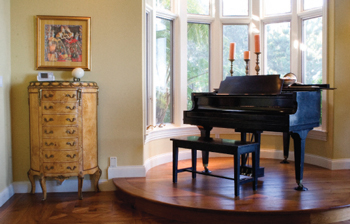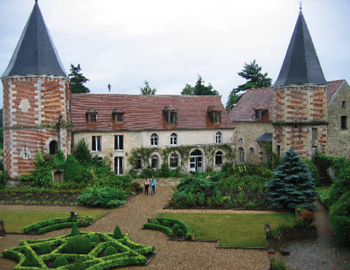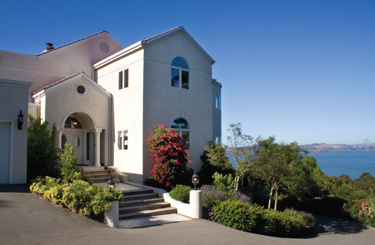Family is important to Matthew Le Merle and Alison Davis, and so is the time they spend together. The English-born couple has five children at home—Max, Tallulah, Louis, Felix and Leo—and a large extended family living abroad.
So when they sought a second home, they looked for one where they could welcome all the relatives at any one time and accommodate friends in summer. They also wanted their children to be acquainted with their European heritage.
In 2001, after a yearlong search, they found the 15th-century Château d’Oigny en Valois, an officially registered Monument Historique in France, where they now spend Christmas, Easter, summer and other vacations.
While choosing a château makes sense given the family’s origins, they purposely didn’t look for one in Southern France, with its Mediterranean climate, olives, lavender and stucco homes. “We have all of that in Tiburon,” says Le Merle, co-president of the angel investment firm Keiretsu Forum of San Francisco and the North Bay. “We wanted our second home to be different.”
He and Davis, managing partner of the private equity firm Belvedere Capital LP, found their Tiburon home 11 years ago after a long, fruitless search on the Peninsula, says Le Merle. Only one day of house-hunting in Marin convinced them “this was the place to be.” Here their spacious Mediterranean-style home is set on six acres with wraparound and water views, a sports court and gardens filled with lavender, lemons, herbs and roses. Inside, colonnades, curved walls, pitched ceilings and large spaces define many rooms.
Several spaces, including the kitchen, living, media and children’s rooms, underwent some stylish but practical changes in a recent redesign by Yvonne Lowry of Transform Your Décor in Tiburon and her design partner Alycia Freeman. The kitchen has a fresh coat of paint and new hardware; designed for entertaining, it also has a fireplace, twin islands and refrigerators, and multiple workstations. This is where the family eats, but when guests come meals are served at a dining room table that cleverly converts into one for billiards.
 “My favorite space is the grand living room,” Lowry says. “It has large curvy sofas in a fern-green crushed velvet, parquet floors and a wall of windows that face the bay.”
“My favorite space is the grand living room,” Lowry says. “It has large curvy sofas in a fern-green crushed velvet, parquet floors and a wall of windows that face the bay.”
There are other rooms that might easily qualify as favorites—the wine cellar, gym, study or library—but the Le Merle children especially like the indoor pool, where Lowry has incorporated outdoor-like colors: a watery blue for the ceiling and a Mediterranean sky blue for the columns.
Lowry consulted each child about preferences for bedroom decor. Tallulah picked soft pink with accents of orange; Louis suggested a skateboarding theme; Leo chose a football motif and Felix a safari one. Max, the oldest, went for sophisticated neutral colors and pieces from the family’s art collection.
Image 2: The alcove off living room is ideal space for piano.
A Château’s Colorful Past
Château d’Oigny en Valois, an ancient 25-acre property, is in the historical heart of France, an hour north of Paris, a half hour from the Champagne region and 40 minutes from Charles de Gaulle International Airport. Shopping, museums and Disneyland Paris are nearby.
The village of Oigny was once a simple Gallo-Roman settlement in a forest clearing. Today it’s home to about 200 residents who live in “just a few-score houses and even fewer farms and larger residences, arranged around the village green with its Romanesque church and the château,” says Le Merle.
The current château, built on the foundations of an earlier one, is a graceful three-story medieval brick building constructed with Renaissance influences and all the requisite status symbols of that era—a moat (now gone), towers, spires, and pigeonnaires—and even a secret subterranean dungeon. Only 10 families, including the Le Merles, have owned it in the last 300 years. “We’re the new kids on the block,” Davis says.
Despite inevitable changes, the château, and life around it, remains firmly anchored in both past and present. Beyond the ancient stone wall lies the dense Forêt de Retz, a former royal hunting ground where handsome stags and small game once eluded aristocratic parties. Today the government owns the 50,000-acre forest, visitors are welcome to bike, hike and horseback-ride its trails, and hunting, on horseback or foot, still takes place. “It’s not unusual to be driving along and suddenly be surprised by a pack of hounds and then a troop of blue-jacketed horsemen appearing from one forest, crossing the road, and disappearing into the forests on the other side, with the sound of their [brass] horns the only proof that they have been there,” Le Merle says.
The Château Today
 The house itself is “a magical place—you lose all track of time when you’re there,” says Lowry, who helped redesign several of its rooms with Freeman.
The house itself is “a magical place—you lose all track of time when you’re there,” says Lowry, who helped redesign several of its rooms with Freeman.
The main floor consists of high-ceilinged rooms with fireplaces; a stylish salle à manger with red silk walls, paned windows, stone floors, exposed-beam ceiling and two dining tables; an elegant wood-paneled parquet-floored salon; an intimate bibliothèque; a game room; a butler’s pantry and an updated cuisine. A spiral limestone staircase leads to the two floors above.
Of the eight bedrooms, some have large fireplaces, most have their own bathrooms, two are located within a tower, and almost all have views of the countryside or gardens. The master suite, in one of the spiral towers, connects to a salon privée via a curved staircase carpeted in a leopard print Lowry found at the Paris Design Center. It’s inspired by one at the nearby Palais de Compiègne, erstwhile home of Empress Eugénie, who was wedded to Napoleon III.
Visiting older children like to stay in the more casual relais across the garden from the château; there, they “play music and games hang out away from the adults,” Davis says. This guest house has two bedrooms, a sitting room, a bathroom and a carpeted loft that can easily host a slumber party of 20 or more. The kitchen is outfitted with a fireplace and pizza oven and can be stocked with party snacks and beverages for hungry teens.
More romantic is the ivy-covered stone gatehouse with a private bedroom on one level and a cozy sitting room with fireplace and views on the other. By tradition, any girl married in the village can spend her honeymoon night here. The offer is still open, says Le Merle, but “no one has asked since we arrived.”
Mornings are informal at the château. Guests enjoy a simple breakfast before exploring the local countryside, visiting Paris or just relaxing. They return in the evening and linger over dinner. “If the weather is nice,” Davis says, “we often dine under the stars on the patio overlooking the gardens and watch the bats come out of towers as the dark falls.”
In the evening, the Le Merle children head to the village green for a soccer game, or to play guitars and visit with friends from the village. “We don’t have television and discourage computers and Game Boys, so most visiting families are surprised to see how much fun the children have without any ‘connected’ access or stimulation,” Le Merle says.
The Château’s Gardens
“Like most rural châteaux in France, Oigny was built to be self-contained,” he points out. Accordingly, its diverse collection of buildings includes a basse-cour with barnyard, stables (now converted to a gym, art studio and storage) and farmhouse. The original landscaping was designed in the 1800s by one of the château’s most notable owners, Henri Charpentier, a general in Napoleon Bonaparte’s army. He is credited with adding the meadows and many of the trees. The floral gardens were later renovated and up until recently received 100,000 visitors a year.
Today, three pairs of brilliantly feathered peafowl roam the grounds. A trio of part-time gardeners maintains the formal gardens, laid out in a parterre with a knot garden and classically shaped topiaries.
These lead to a lower pond, an arboretum and an enclosed garden room with an astrological motif.
The Château in the 21st Century
The Le Merles open the gardens to the public on Bastille Day and in October for the Journées du Patrimoine dedicated to French history and culture. Le Merle’s mother has researched and documented the château’s history, and his son Max has created a website for it (chateauoigny.com). In California, the family has auctioned off weeklong stays at the château, bringing in about $200,000 for such local entities as the Marin Rowing Association, the Baroque Philharmonic Orchestra and Reed school.
Château d’Oigny has been owned by titled seigneurs, French commoners and now the Le Merles—and while all owners are entitled to change their name to De Oigny, the newcomers are not so inclined.
As Le Merle explains, they see themselves as “temporary custodians for one of France’s most important historical monuments.”
Image 3: Exterior shot of Château d’Oigny and gardens.


